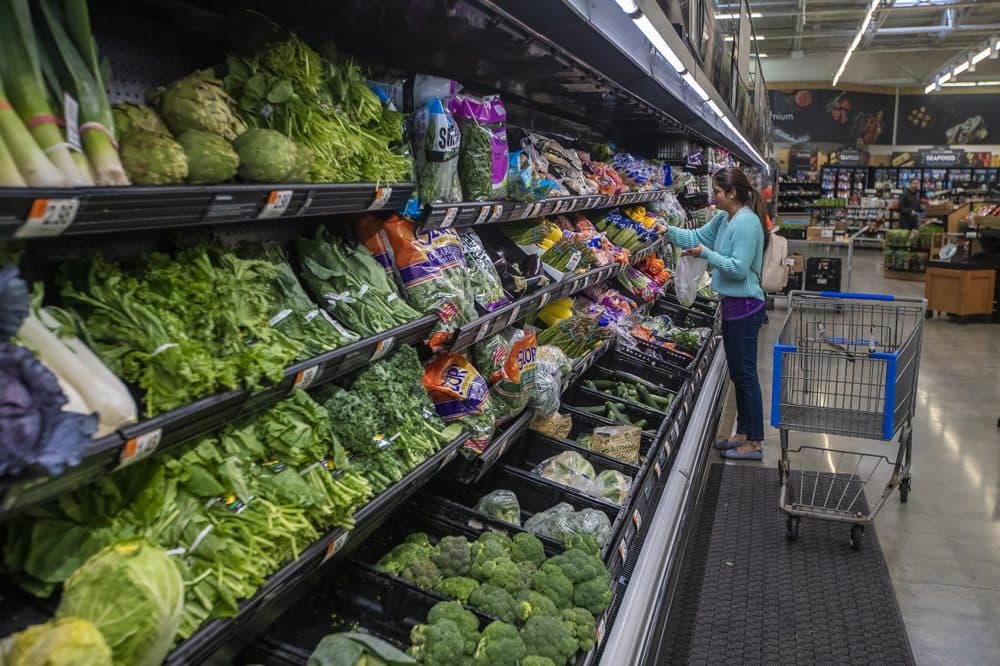Advertisement
Health Care Costs Of Unhealthy American Diet? At Least $50B A Year, Study Estimates

At least $50 billion. That's the cost to the American health care system of unhealthy eating, Boston researchers estimate.
They used national data to calculate the impact of 10 major food groups, and figure at least 20% of the costs for heart disease and diabetes care can be chalked up to unhealthier choices with those foods — from not eating enough whole grains and nuts to having too much processed meat and soda.
I spoke with Dr. Thomas Gaziano of Harvard Medical School — senior author on the study by Tufts and Brigham and Women's Hospital researchers in this week's PLOS Medicine — about what the findings mean for people and policy.
It's a lot — $50 billion — but I'm actually surprised it's not more, because we tend to blame a lot of heart disease and diabetes on diet.
Actually, there are estimates that an unhealthy diet accounts for probably 40 to 45% of health care costs for chronic cardiovascular diseases. We have restricted this to 10 items where there's the most robust data on the types of food, and we have done a meta-analysis to confirm the exact effects of reductions in stroke, heart attack, blood pressure, obesity.
There are also effects of diet on cancer and other diseases. This study is really restricted in terms of cardiovascular care. So yes, there are estimates that are much higher than the 20%.
So this was quite a conservative calculation. What were the elements that made the most difference?
On the positive side: fruits and vegetables, nuts, whole grains and seafoods that are rich in Omega-3 oils; on the negative side, processed meats and sugar-sweetened beverages.
How much of a difference would those make if we all ate optimally?
If you're eating enough fruits and vegetables, the whole grains, the nuts, and the absence of the sugar-sweetened beverages would add up to about 75 or 80% of what we discussed.
What do you see as the biggest take-home messages from this?
There's the personal level and the policy level. Food is an immense part of people's culture, and this time of year, it's intensified, whether it's Christmas or Hanukkah or people thinking about their New Year's resolutions and how they can be healthier. There are some simple choices that people can make at the grocery store, or when purchasing gifts for other people, that can really improve their diets just by increasing a few items of fruits or vegetables per day, or nuts, and restraining the sugar-sweetened beverages and processed meats. That would go a long way to improve their health as individuals.
At the policy level, there are immense potential levers that the government can introduce that would be revenue-neutral. We've looked at a SNAP program that would be able to incentivize the purchasing of healthier foods by up to 20 or 30%, matched with increasing the pricing or taxing of the unhealthy food items that we evaluated. That could remain revenue-neutral for people who are in the SNAP program.
Advertisement
We found the biggest gains for people who are older or poor. People receiving Medicare or Medicaid had almost double the gains of the average population. So programs that incentivize prescriptions through Medicare and Medicaid program are other alternatives for encouraging people to eat healthy foods and restrict the unhealthy choices.
So is this a trend that's coming? Prescriptions for healthier food?
Providers are always talking about healthier diets. If I were able to give patients a prescription that was backed up by store discounts, through Medicare or Medicaid, that would be far more powerful because then they would have a significant incentive to carry out that prescription.
Our grandmothers say to eat better, our doctors say to eat better, and we try really hard, but there are obstacles. It's not just taxing and subsidizing foods, but through the farm bill and other activities we need to make sure that these foods are available at the grocery stores, that we don't have tariffs on foods coming from Mexico or other places so that healthy foods can be cheap and available.
The list of healthier foods sounds expensive: seafood, nuts, produce — not cheap. It's a money issue.
It's two issues: It's money and availability: Are these foods available in the grocery stores in their neighborhoods? Those incentives have to be at the policy level. An individual can't ask the grocery store to stock something. There have to be incentives to make the owners of grocery stores want to supply these items.
Not all of the healthier items are expensive, but fish and some nuts are. But the idea is you could subsidize the healthy foods by taxing the unhealthy ones to keep it revenue neutral, which then saves the health care system money.
Medicare would need to be involved in this, talking to the Agriculture Department and saying, 'Look, you provide healthier foods and we incentivize to get them to the table, we save resources overall. It would take higher-level thinking across agencies.
All in all, why did you undertake this study?
Because it hadn't been done. We wanted to get a sense of how much could be saved by improvements in these diets. If we could save $50 billion dollars by getting people to eat what we recommend, that would seem to make sense. This is what moves policymakers, not just that these foods are healthy, but that not eating a healthy diet costs our health care system quite a bit.
This conversation has been lightly edited.
